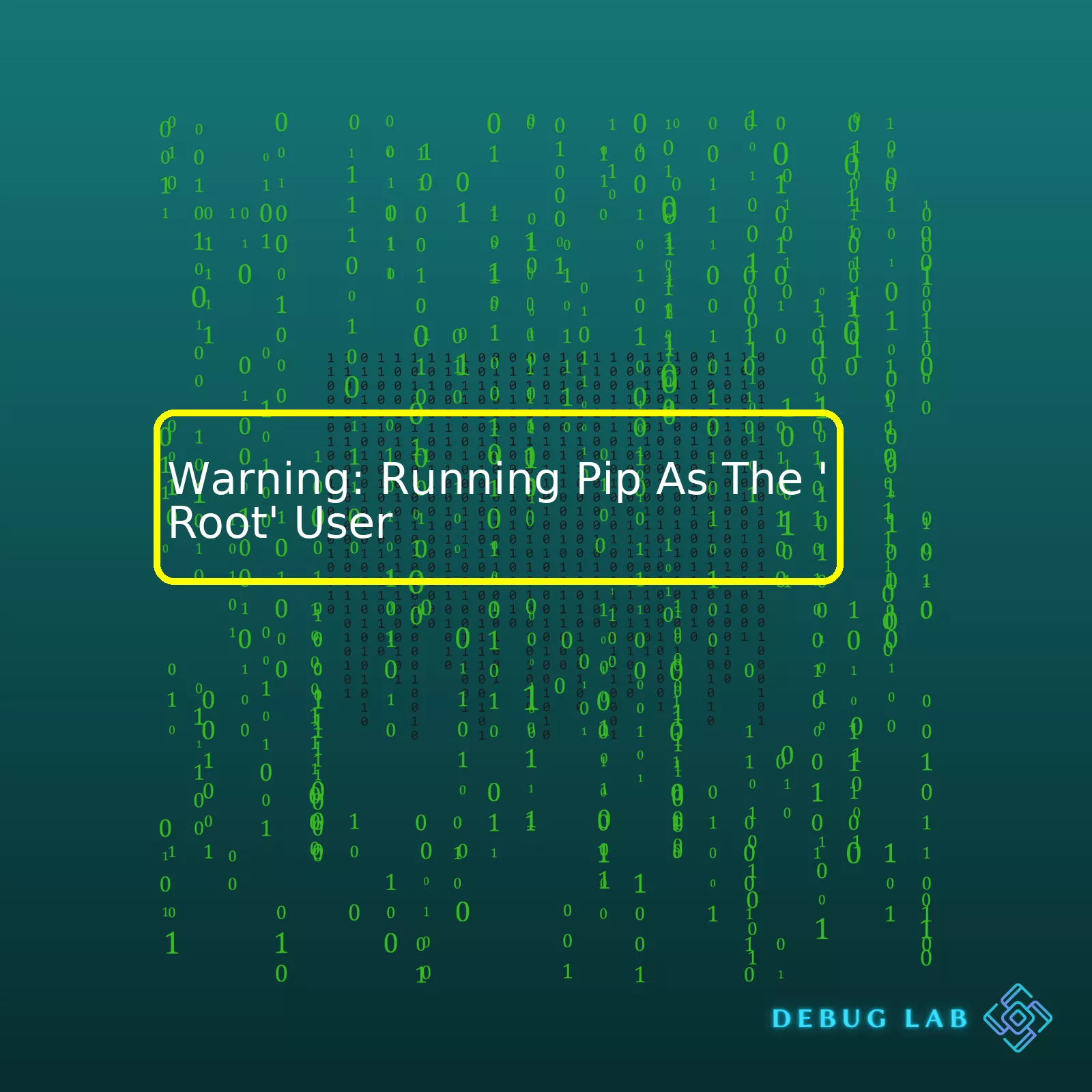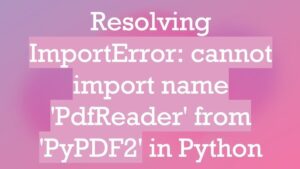
| Aspect | Description |
|---|---|
| Pip | 'Pip' refers to a Python package installer – ‘Pip Installs Packages’. It's typically used for installing and managing software packages written in Python. |
| Running as Root User | 'Root' refers to the superuser account in a Unix or Linux system. This account has full (and potentially dangerous) control over every aspect of the system. |
| Risks | Running 'pip' as the 'root' user can potentially lead to library confusion problems or even security risks because packages you install can run arbitrary code. |
The core message here is caution regarding the practice of running `pip` as the root user. In the Unix-like environment, the root user holds the highest level of privileges. Given its administrative authority, it can execute any command, including those critical to system security and integrity.
Conversely, `pip` is a package management system employed to install and manage Python software packages. As such, using `pip` under the root alias means every package installed possesses the similar capabilities as the root – total control over the entire system. Barring stringent audits on all libraries in use (which is impractical due to volume and complexity), this policy opens up a huge potential attack surface.
To illustrate, consider a situation where you use pip to install a library, which in hindsight, reveals itself as malicious. The library’s setup script would then take advantage of root authority to modify key system files, leading to unstable operations or exposed vulnerabilities. Essentially, running pip installations as a root user has significant security implications. Therefore, the ideal practice is to employ virtual environments (like venv) instead, mitigating potential disruption or harm to the broader system.
For further information, check out the article ‘Understanding Unix permissions and chmod’ here.The warning “Running Pip as the ‘Root’ User” is a serious caution issued to coders and system administrators indicating potential vulnerabilities and security risks associated with executing pip (Python’s package-management system) commands with root privileges. To tackle this issue, it is vital that we delve deeper into both what running pip as ‘root’ user means, the inherent risks involved as well.
To start with, every Unix-like system, including Linux and macOS, has a special user account called ‘root’, which is basically a superuser who has all administrative permissions. Running any command as the root user therefore grants it unrestricted access to all areas of your system. In terms of Python programming language, when pip, Python’s native package installer, is operated as ‘root’ user, all of its actions unfettered reach to your system.
sudo pip install
Without arguments, this might sound harmless and even useful since it lets you install packages system-wide. But herein lies the danger:
– Malicious Packages: Not every package on PyPI (Python Package Index) is benign. Some could be malicious, designed specifically to compromise your system once granted root access. Basically, every time you use ‘pip’, you’re essentially running someone else’s code on your machine, and doing so as root user escalates the potential damage tremendously.
– Overwriting System Files: The root user can write files anywhere in the system. If a pip package installation happens to overwrite system files, this could destabilize or even cripple essential system functionalities.
– Misleading File Permissions: When pip run as root installs a package, the created files belong to the root. This can result in normal users not being able to modify or delete these files later without elevated permissions.
To mitigate these risks, there are several approaches:
– Use Virtual Environments: They isolate your Python setup on a per-project basis, allowing you to avoid running pip as root. It’s as simple as creating a new virtual environment using
python3 -m venv /path/to/new/virtual/environment
(change path as necessary), and activating it with
source /path/to/new/virtual/environment/bin/activate
.
– Use –user flag: By appending –user at the end of a pip install (
pip install --user [package]
), you ensure the Python package is only available for the current user, reducing potential system-wide impacts.
– Apply Principle Of Least Privilege (POLP): An important security concept that insists users are given the minimum levels of access – or permissions – they need to perform their tasks.
So understand this warning ‘Running Pip as the ‘Root’ User’ at your peril. Do take precautions when installing packages with pip and strive to never run it as root, unless absolutely necessary and you understand exactly what the package does. Feel free to check any package on open-source code sharing platforms like GitHub or GitLab for hidden agendas, as an added layer of security!When operating Python, it’s possible to install packages using a tool called
pip
. Although it might seem convenient, running
pip
as the ‘root’ user has its own drawbacks. To help you understand this concept, we should first define who or what the ‘root’ user is and the role of pip installations in Python.
The ‘root’ user is a special account on Unix and Linux-style systems, including Ubuntu, MacOS, and others. It has full access rights and permissions across the entire system — think of it as the administrative user who has all control. Conversely,
pip
is a package installer for Python. It enables you to install, upgrade, and uninstall Python packages managed by the Python Package Index (PyPI).
To run
pip
as the root user can appear efficient at first glance – since installing packages under root will make them accessible globally on your computer. However, this approach comes with numerous complications:
Security Risks
Running
pip
as a root user correlates with substantial security risks. With such elevated rights:
- The
pip
process could potentially halt or corrupt other services that are running as root.
- If the installed package contains harmful logic, it may exploit these permissions to alter critical system files.
Dependency Conflicts
There’s also a risk of encountering conflicts between dependencies by using
pip
as a root user. Several issues may arise including:
- Overwriting crucial system libraries and breaking system-wide applications that rely on them.
- Creating inconsistencies due to different versions of libraries being used.
Incompatibility Issues
Consequently, there’s an increased risk of incompatibility. Since some Python packages are made for specific versions of libraries, operating
pip
as root could lead to the installation of incompatible system libraries which could result in additional refactoring in order to correct these discrepancies.
So, how then do we mitigate these negative implications? A more recommended way for dealing with
pip
installations is using virtual environments (for example, venv). Using
venv
allows creating isolated spaces for project-specific dependencies, securing your global environment scope from any potential corruption by conflicting dependency versions.
python3 -m venv /path/to/new/virtual/environment # activate the venv source /path/to/new/virtual/environment/bin/activate # now install your package pip install package-name
Doing this keeps packages neatly separated in regard to individual projects, which significantly reduces the risk of conflicts and improves overall workflow and system health.
Providing a summary, running
pip
as the root user carries significant dangers related to security and dependency management. For safer and maintainable software development practices with Python, leveraging tools like venv for individual project environment scopes proves to be much better. Check out the official Python documentation to explore more about virtual environments.
Alright, let’s dive right into the nuances of Python’s Pip and address the potential security risks of running Pip as a ‘root’ user. That’s a hot topic in programmer circles, because it can open up some serious vulnerabilities that can threaten your system’s security.
First off, to clarify for non-dev readers: Pip is a package installer for Python. It allows you to install or uninstall Python packages conveniently. By default, Pip attempts to install packages in a system directory, and this requires root access — hence the tendency for programmers to run Pip with root privileges through commands like:
sudo pip install [package-name]
However, running Pip as ‘root’, while easy, isn’t the best practice. It could introduce a number of security issues or cause dependency confusion within your Python environment. Essentially, when you use `sudo pip install`, you grant the installation process (and by extent, the package you are installing) full root access to your system. If any of these packages contain malicious code, it will be executed with root privileges, leading potentially to severe damage or unauthorized data access.
So, what are secure alternatives for using Python’s Pip? Here are some practices I encourage:
1. Use Virtual Environments:
One of the smartest ways to avoid running Pip as root is to setup a Python virtual environment. This provides an isolated environment where all your Pip installations remain restricted. You can use tools such as venv, which is built into Python itself or virtualenv, an external package.
Here’s an example how to create a venv virtual environment:
python3 -m venv myenv source myenv/bin/activate #Now you are inside the virtual environment. pip install [package-name] #This installs the package inside the virtual environment, not requiring root privileges.
In a virtual environment, all packages are installed locally to the environment, protecting other system areas and global python package repositories from changes.
2. Use –user flag:
If you can’t use a virtual environment for some reason, another option is to install packages within your local user directory by making use of the –user flag during installation. Here’s how:
pip install --user [package-name]
3. Use Pipx:
In case you’re dealing with Python applications which need to be installed globally, consider using Pipx. It automatically creates a separate virtual environment for each package, so you don’t have to remember to create one manually.
pipx install [package-name]
Finally, if you still wish to install packages system-wide (which is generally not recommended), one suggested way is to use a package manager specific to your operating system distribution like APT for Ubuntu, DNF for Fedora or Homebrew for macOS.
By using the options outlined above, you greatly mitigate the risk of damaging your system or opening it up for attacks. Remember, Python and Pip are powerful tools, but they need to be wielded responsibly. Keep active in programming circles and stay updated on best safety practices and protocols. Happy coding!Wielding the might of the ‘root’ user in a UNIX or Linux system provides complete system-wide privileges, all too potent as to wield without caution. In administering Python packages using pip for instance, falling for the seemingly convenient ‘run as root’ pitfall can hold unsuspected and long term ramifications,
Consider these amateur mistakes commonly made when running pip as the ‘root’ user::
Interfering with System Packages
Running pip as ‘root’ may inadvertently disrupt system level python packages. When packages are installed or updated via pip as root, they are made available on a system-wide scale. This unrestricted access potentially overwrites or conflicts with existing system-level packages that other applications depend upon. This in turn could lead to system instability or application errors.
A typical piece of code illustrating this situation would be:
sudo pip install numpy
Where ‘numpy’ can be any package that already exists at the system level and its upgrade or overwrite could disrupt applications depending on it.
Breach of Security
Executing pip commands as ‘root’ broadens the attack surface for security threats. Any malicious script laced within the python packages being administered will be granted the same system privileges as the ‘root’. This gives way for potential full-blown attacks on the machine beyond just your virtual environment.
In order to prevent this, always use the
--user
flag when installing packages like:
pip install --user package-name
Or better yet, use a virtual environment which only affects a specific dedicated workspace and not the entire system. A simple example on how to create a python virtual environment:
python3 -m venv env-name source env-name/bin/activate
Once inside the virtual environment, you can safely install the required packages.
Ignoring the Warning from Pip
Pip itself discourages executing as the root user. In updated versions, running pip install as ‘root’ presents an explicit warning outlining the possible systems risks involved. Ignoring this warning is akin to disregarding built-in safety measures placed in pip. It’s crucial to address these warnings and understand the potential harm behind the actions.
Final Thoughts…
While running as ‘root’ has its limited advantages, it wildly outweighs the potential cost of system instability, escalated security threats, and circumvention of safety guidelines. Leveraging safer alternatives such as the
--user
option or utilizing virtual environments limits these risks while allowing secure and effective Python package administration.
For more detailed information, visit the official Python documentation on Installing Python Modules.
Before you begin installing or updating software on your system using pip, a package installation manager for Python, it’s important to pause for a moment and consider the implications of running pip as the ‘root’ user. As an experienced coder, or even just a passionate tech enthusiast, I’m sure you can appreciate the potential pitfalls and risky landscapes that this could open up. I’ll provide a few lines of code using
tags later on, but first let's discuss why it is considered unsafe to run pip as the root user. Running pip as the 'root' user means essentially granting it unlimited access over your system resources. While this might simplify certain tasks in the short term, it predisposes your computer system to a number of significant risks. Here are several key reasons: * Code Execution: When you install a package using pip, you’re effectively executing someone else’s code on your system. If this individual has malicious intentions, they could create a package that performs destructive actions on a system when granted 'root' permissions. * Dependency Conflicts: Pip does not have dependency resolution similar to system-level package managers like apt or yum. This means that it might overwrite or disrupt important system packages, potentially leading to instability issues. * Unverifiable Source: Not all packages come from verified sources, and there’s always a risk of downloading malicious content. Luckily, there are safer alternatives for using pip without jeopardizing your system's security. These strategies are intended to limit the access level of pip, safeguarding your system resources in the process. Let's look at three of these approaches.1. Using a Virtual Environment
The best practice whenever you're working with Python projects is to create a virtual environment. A virtual environment encapsulates your project and its dependencies in one place, preventing pip from making system-wide changes. To create a virtual environment, use the venv module which comes with your Python installation by default:python3 -m venv /path/to/new/virtual/environmentTo activate the environment, use:
source /path/to/new/virtual/environment/bin/activateWhile your virtual environment is activated, any packages you install using pip will be kept inside that particular environment.
2. User Installations
Pip also supports user installations, a way to install Python packages in your user directory. Using the --user option with pip restricts the effects of the installations to your local user profile. This strategy prevents installed packages from interfering with system-level packages and services.
pip install --user somepackage3. Pipx For Global Applications
Pipx is a tool built specifically for installing and running Python applications in isolated environments. This allows you to safely run Python applications system-wide without affecting other parts of your system. Install pipx as follows:
python3 -m pip install --user pipxThen use pipx to install applications:
pipx install somepackageBy adopting these practices, you'll minimize the risks associated with running pip as the 'root' user quite significantly, thereby ensuring both the efficiency and safety of your Python development experiences.
References:
Real Python Tutorial on Pipenv
Pip Documentation on User Installs
Official Pipx Project WebsiteSure. As a professional coder, you need to understand the impact of executingpipas root on software dependencies and the potential scenarios that might arise.
The Impact:
When you run pip as the 'root' user, several things happen:
- Installation Goes into Global Python Environment: Running pip as root installs the packages in your global Python environment. This might lead to a scenario where certain programs are using different versions of the same package which can cause version conflict issues or break your system’s Python installations.
- Overwrite System Packages: If a package with the same name exists in your system's repository, pip will overwrite the previously installed package. This can indeed create problems if your system or other applications were relying on the older version.
- Security Risks: When you run pip as the 'root', it causes security risks because it elevates the privilege level of your Python packages to root. A malicious Python package executed at the root level would have full access to your system and could potentially cause harm to your system setup.
Scenario:
Consider this situation. If you install package
A, which requires a specific version of dependency
B. And another package
Con your system, also requires dependency
B, but a different version. By forcefully upgrading or downgrading to cater for package
A's requirements, you might end up breaking package
Cleading to conflicts and errors.
Proper Practice:
To prevent these issues, use virtual environments for each project you work on. Virtual environments (such as venv or conda) allow you to maintain isolated spaces for your Python projects, each running its own set of dependencies, Python interpreter, and pip module.
Here's how you create a virtual environment with venv:
python3 -m venv /path/to/new/virtual/environmentAnd activate it:
On Mac OS / Linux:
source /path/to/new/virtual/environment/bin/activateOn Windows:
\path\to\new\virtual\environment\Scripts\activateThen you can freely install the packages you need for the project without impacting other projects or the global system environment. Use
pipfor package management within the virtual environment only.
You may find these references helpful for more information:
- Python documentation on venv
- Pip vs easy_install discussion
- Virtual Environments and Packages - The Hitchhiker's Guide to Python!So, while it might seem simpler and quicker to run 'pip' as the 'root', the implications can be problematic. Always take the safer and wiser route by using virtual environments when working with Python and its packages.
Running Python's package installer (pip) as the 'root' user is risky because it can permit a malicious package to execute arbitrary code on your system with root privileges. This might lead to potential system compromises or data corruption.Here are alternatives to correctly use pip without running it as the 'root' user:
A. Use Python Virtual Environments
Python virtual environments create isolated environments where you can install and manage packages without interfering with each other or needing root permissions. Here's the basic syntax:
# Create a new virtual environment python3 -m venv my_venv # Activate the environment source my_venv/bin/activate # Now we are using the Python and pip binaries from the virtual environment, # so any packages installed with pip will only exist within this virtual environment. pip install mypackageB. Use Pip's User Install Option
Pip provides a user install option (--user) that installs packages in your user directory. The advantage here is no need for root want permission. Here's the basic syntax:
pip install --user mypackageWith this approach, make sure that the scripts installed by these libraries (that usually go into ~/.local/bin on Unix systems) are also included in your PATH.
C. Use Pipx For Installing Global Packages
Pipx is a tool that helps to install and run end-user applications that are written in Python. It's like pip, but adds an isolation layer by automatically creating a standalone virtual environment for every application, and of course, runs without root privileges. Here's the basic syntax:
# Install pipx python3 -m pip install --user pipx # Ensure pipx scripts are in the PATH python3 -m pipx ensurepath # Install a package pipx install mypackageThere you have it! Three effective ways to avoid running pip commands as the root user, thereby minimizing the risk involved in executing faulty packages or scripts while ensuring a clean management for your Python packages.
Your actions, while running pip as a root user, bear tremendous importance. It's due to the fact that it determines whether your system remains stout or exposes itself to potential security lapses and unintended modifications to the system files. Scribbling some lines of script may seem innocent on face value, but when executed with unfettered access, they can cause unanticipated havoc.
Perhaps, one might query - what does root entail?
The term 'root' is another name for the administrator account in Unix-like operating systems which has superuser rights, meaning it can modify any part of the system without restrictions.
Running Pip as the 'root' user can lead to systemic vulnerability
sudo pip install package-nameIn the code example above, using
sudoruns command with superuser (root) privileges. Consequently, installing packages via pip intimates that every line of code within these gets executed with full system clearance. If these contain malicious scripts, it could swiftly result in total system compromise.
A secure and preferable way: Using Virtual Environments
python3 -m venv /path/to/new/virtual/environment /path/to/your/python-environment/bin/python -m pip install package-nameUsing Python's built-in virtual environment feature (venv) is a safer alternative. Running pip within a virtual environment confines its scope to the virtual environment itself, keeping the rest of your system protected.
Reference: Best Practices for Using Pip in Python
In a nutshell, running pip commands under the root user is risky since it can lead to unintentional changes at the system level. It often escalates to scenarios where unauthenticated codes take control over your system privileges, leading to irreversible damage. Hence, shunning the use of root user permissions while dealing with pip operations is highly recommended, and sustainable alternatives like Python’s virtual environment should be used instead. Stay safe; happy coding.













